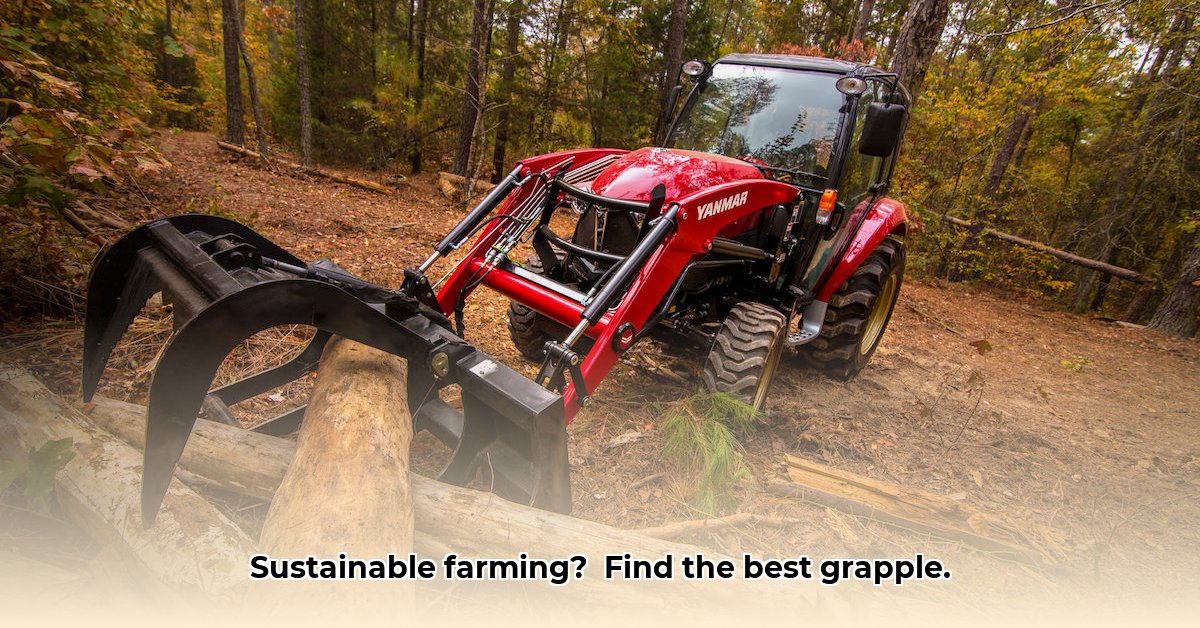
Choosing the right tractor grapple is crucial for efficient and sustainable farming. This guide provides a structured approach to selecting the best grapple for your needs and budget, minimizing environmental impact while maximizing productivity. For additional tractor implements, check out this helpful resource.
Understanding Your Grapple Options
Several grapple types cater to different needs. Each offers unique advantages and disadvantages which directly impact your farm's sustainability and efficiency.
Root Grapples
These heavy-duty grapples excel at clearing stubborn tree roots and thick brush. Their powerful jaws efficiently handle deeply embedded materials. However, their robust construction means they are heavier and may require a more powerful tractor.
Grapple Rakes
Offering greater versatility than root grapples, these are ideal for handling a variety of materials such as hay bales, brush piles, and smaller debris. Their lighter weight makes them easier to maneuver and less demanding on your tractor's hydraulic system.
Rock Buckets
These specialized grapples are designed for moving rocks and large debris. Their durable construction withstands impacts from heavy stones, but this specialized design limits their adaptability for other tasks.
Debris Grapples
These lighter-duty grapples are ideal for clearing lighter debris and brush. They offer greater agility and are often a suitable choice for smaller tractors or tasks that don't require heavy-duty capabilities.
Key Factors for Grapple Selection
Selecting the perfect grapple requires careful consideration beyond initial cost. Several critical factors directly impact your farm's long-term sustainability and operational efficiency.
Tractor Compatibility: Matching Power and Capacity
- Horsepower: A grapple too large for your tractor's horsepower will struggle, leading to inefficiency and potential damage. Always consult manufacturer recommendations.
- Lift Capacity: Your tractor must lift the grapple's weight plus the material being moved; overloading is dangerous. Check your tractor's manual for the maximum lift capacity.
- Hydraulic Flow Rate: A sufficient flow rate ensures smooth grapple operation; insufficient flow significantly slows down work.
Budget: Balancing Initial Cost and Long-Term Expenses
- Initial Purchase Price: Grapple prices vary widely; compare quotes from multiple suppliers.
- Maintenance and Repair Costs: A cheaper grapple may cost more over time due to repairs; consider build quality and parts availability.
Operational Needs: Task-Specific Grapple Selection
- Material Handling: What materials will you primarily move? The material type dictates the appropriate grapple type. A grapple designed for hay won't efficiently move rocks.
- Farm Size and Operations: Larger farms may require a larger, heavier-duty grapple, while smaller farms might find a lighter grapple more suitable.
Environmental Impact: Sustainable Farming Practices
- Materials: Prioritize grapples made from durable, recycled materials to reduce your environmental footprint.
- Manufacturing Processes: Research manufacturers committed to sustainable and environmentally conscious production processes.
- Soil Health: Heavy grapples can compact soil; use best practices to minimize compaction, such as avoiding excessive weight and optimizing working methods. "Minimizing soil compaction is critical for maintaining soil health and maximizing crop yields," says Dr. Emily Carter, Soil Scientist at Cornell University.
A Step-by-Step Guide to Grapple Selection
- Assess Your Needs: Carefully analyze your farming operations and the materials you'll handle.
- Research Compatible Grapples: Research grapple types and sizes compatible with your tractor, ensuring a proper fit.
- Gather Quotes: Obtain quotes from multiple reputable suppliers and compare pricing and features.
- Calculate Total Cost of Ownership: Include initial cost, estimated maintenance, and repair expenses.
- Make Your Purchase: Choose the grapple that best meets your needs and budget.
- Proper Installation: Follow manufacturer instructions meticulously for safe and efficient operation.
Maintenance and Safety: Ensuring Long-Term Performance
Regular maintenance and safe operation practices are crucial.
- Regular Inspections: Inspect the grapple before each use for wear, loose connections, leaks, or damage.
- Lubrication: Regular lubrication reduces wear and extends the grapple’s lifespan.
- Safe Operating Procedures: Follow manufacturer safety guidelines and use appropriate personal protective equipment (PPE).
Conclusion: Investing in Sustainable Farming Practices
Choosing the right tractor grapple is a crucial decision impacting your farm's efficiency and sustainability. By carefully considering tractor compatibility, budget, operational needs, and environmental impact, you can make an informed choice that supports your long-term farming goals. Remember, prioritizing safety is paramount. Proper maintenance and safe operating practices will ensure your grapple's long-term efficiency and minimize risks.